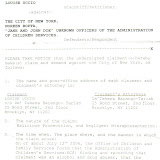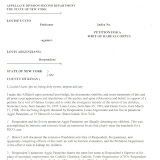
FYIAlison Bass hits the bull's eye in an Op Ed column in The Boston Globe (below) by exposing corporate psychiatry's manipulation of suicide rates asa public relations tool!
Similarly, an Op Ed in The New York Times by Christopher Lane (below), aprofessor of English at Northwestern, the author of the forthcoming"Shyness: How Normal Behavior Became a Sickness," skewers psychiatrists whoare pathologizing normal children's behavior in order to medicate them. "Itmay seem baffling, even bizarre, that ordinary shyness could assume thedimension of a mental disease. But if a youngster is reserved, the odds arehigh that a psychiatrist will diagnose social anxiety disorder and recommendtreatment."
In an effort to answer the question, "How much credence should we give thediagnosis?"He notes that the revised third edition of the Diagnostic Statistical Manual(1987), psychiatry's "bible" for diagnosing mental illness, "expanded thelist of symptoms by adding anticipated concern about saying the wrong thing,a trait known to just about everyone on the planet. The diagnostic bar wasset so low that even a preschooler could trip over it." See industry'spervasive influence in what's included in the DSM.
http://ahrp.blogspot.com/2007/04/leading-american-psychiatrist-calls-dsm.html
As any scientist (or educated layperson) knows, trends in suicide rates,like any epidemiological data, have to be looked at over the long termbecause a one-year variation in rates could be a statistical artifact, ormean something else entirely.
Industry's dilemma: the overwhelming validated scientific evidence fromcontrolled trials confirms an INCREASED RISK of suicidal behavior inchildren and young adults who are prescribed SSRI antidepressants. Tocounteract the scientific evidence, drug companies hire influentialacademics to manufacture alarming 'findings' to support increased use ofthese drugs.
Such is the case with a much publicized report published in September 2007,the official journal of the American Psychiatric Association (AJP). Theauthors claimed a causal link between a one year increased suicide rate andclaimed reduced prescription rates. These commercially driven unsupportableclaims are an example of junk science. However, major newspapersuncritically reported the unsubstantiated 'alarming study findings' thatsuicides among young people were on the rise because of a precipitous dropin the use of antidepressants.
http://ahrp.blogspot.com/2007/09/more-on-supposed-youth-suicide-rate.html
Alison Bass asks two questions that reporters suffering from shyness areafraid to ask:
1. "Why are some in the psychiatric community, despite lack of evidence,working to convince the American public that the FDA may have erred inputting the most serious kind of warning possible on the use of [SSRIantidepressants] in young people?"
Answer: The alarmist call by such 'pillars of the psychiatric community' asDr. David Shaffer and Dr. J. John Mann of Columbia University, to rescindBlack Box suicide warnings on antidepressant drug labels, may be viewed asprotecting their investment in the antidepressant drug business. Both Dr.Shaffer and Dr. Mann--and an army of other academics who, like them, are 'onthe take'--can be counted upon by drug manufacturers to ring the fire alarmdespite the lack of evidence of any fire.
In fact, Bass, points out, the authors of the AJP study overlooked the factthat prescription rates did not drop in the year when suicide rates amongyouth increased, (2003-2004). Since suicide rates for 2005 are not yetavailable from the Centers for Disease Control and Prevention, there is noevidence of a connection between variations in youth suicide rates andantidepressant prescription usage.
Question 2: "Who stands to benefit from the latest alarm about an apparentupturn in youth suicide rates?"
Answer: The sharp drop in the sale of SSRIs since 2004 has put a big dent intheir manufacturers' bottom line. These companies have an enormous stake inreversing the current FDA warnings. That might explain why Pfizer (the makerof Zoloft) contributed $30,000 to cover the cost of collecting data for theAmerican Journal of Psychiatry study, which was also funded by the NationalInstitute of Mental Health.
"It's also worth noting that the two lead authors of the paper havedisclosed financial conflicts of interest: Columbia professor of psychiatryDr. John Mann has been a paid consultant to at least two SSRI makers, Pfizerand GlaxoSmithKline (the maker of Paxil), and Robert Gibbons has served asan expert witness for Wyeth Pharmaceuticals (the maker of Effexor, anotherSSRI)."
Contact:
Vera Hassner Sharav 212-595-8974
veracare@ahrp.org
By Alison Bass September 24, 2007
EARLIER THIS MONTH, major newspapers reported the alarming news thatsuicides among young people were on the rise because of a precipitous dropin the use of antidepressants. This news was based on a study in theSeptember issue of the American Journal of Psychiatry, which concluded thatphysicians had been scared away from prescribing antidepressants because ofthe Food and Drug Administration's decision in October 2004 to put black boxwarnings on the pediatric use of these drugs. The FDA mandated the warningsafter finding an increased risk in suicidal thoughts and behaviors amongadolescents taking antidepressants such as Prozac, Zoloft, Paxil, andCelexa.
In the wake of the study, several psychiatrists called for the black boxwarnings to be retracted. "It's time for the agency's warnings to bemodified," opined Dr. David Schaffer, chief of child and adolescentpsychiatry at Columbia University Medical Center in New York City.
News sources have since exposed a big hole in the journal's argument.Several experts quoted in The New York Times and The Boston Globe pointedout that while there was indeed an upturn in suicide rates among youths (anincrease of 14 percent, or a total of 252 more deaths among youths under 19between 2003 and 2004), the number of prescriptions for antidepressants inthe same age group remained basically unchanged between 2003 and 2004.
According to data presented in the American Journal of Psychiatry study,prescription rates for minors did not drop sharply until a year later(between 2004 and 2005). Since suicide rates for 2005 are not yet availablefrom the Centers for Disease Control and Prevention, there is no evidence ofa connection between variations in youth suicide rates and antidepressantprescription usage. Furthermore, experts say that trends in suicide rates,like any epidemiological data, have to be looked at over the long term and aone-year variation in rates could be a statistical artifact, or meansomething else entirely.
So what's going on here? Why are some in the psychiatric community, despitelack of evidence, working to convince the American public that the FDA mayhave erred in putting the most serious kind of warning possible on the useof these drugs in young people? In May, the FDA, after finding the sameincreased risk of suicidal behaviors among young adults taking the class ofantidepressants known as selective serotonin reuptake inhibitors (SSRIs),extended the black box warnings to young adults.
There is no doubt that many psychiatrists believe that antidepressants,particularly SSRIs like Prozac, Paxil, Zoloft, and Celexa, are helpful intreating depression in adults and adolescents. They have seen how thesedrugs have lifted the fog of despair from people with depression.
But there is another factor to consider: Who stands to benefit from thelatest alarm about an apparent upturn in youth suicide rates? The sharp dropin the sale of SSRIs since 2004 has put a big dent in their manufacturers'bottom line. These companies have an enormous stake in reversing the currentFDA warnings. That might explain why Pfizer (the maker of Zoloft)contributed $30,000 to cover the cost of collecting data for the AmericanJournal of Psychiatry study, which was also funded by the National Instituteof Mental Health. It's also worth noting that the two lead authors of thepaper have disclosed financial conflicts of interest: Columbia professor ofpsychiatry Dr. John Mann has been a paid consultant to at least two SSRImakers, Pfizer and GlaxoSmithKline (the maker of Paxil), and Robert Gibbonshas served as an expert witness for Wyeth Pharmaceuticals (the maker ofEffexor, another SSRI).
This isn't the first time that suicide rates have been trotted out as apublic relations weapon. Proponents of psychotropic drugs have long arguedthat suicide rates among adults and children fell after the SSRIs wereintroduced in the United States. However, an examination of long-term trendsin suicide rates indicate that suicides were declining here and in othercountries well before SSRIs such as Prozac, Zoloft, and Paxil were widelyprescribed, says Julie Zito, associate professor of pharmacy and psychiatryat the University of Maryland. Zito says there are other plausible reasonsfor the decline in suicide rates over the last two decades, including a morestable economy, better access to mental healthcare, and gun control.
So until new evidence emerges showing, unequivocally, a rising rate ofsuicides among our youths and a link between those rates and reducedantidepressant usage, it would be wise to treat the latest salvo with ahealthy dose of skepticism.
Alison Bass is a former medical writer for the Globe and author of theupcoming book "Side Effects: A Best-selling Drug on Trial."
C Copyright 2007 The New York Times Company
FAIR USE NOTICE: This may contain copyrighted (© ) material the use of which has not always been specifically authorized by the copyright owner. Such material is made available for educational purposes, to advance understanding of human rights, democracy, scientific, moral, ethical, and social justice issues, etc. It is believed that this constitutes a 'fair use' of any such copyrighted material as provided for in Title 17 U.S.C. section 107 of the US Copyright Law. This material is distributed without profit.























No comments:
Post a Comment